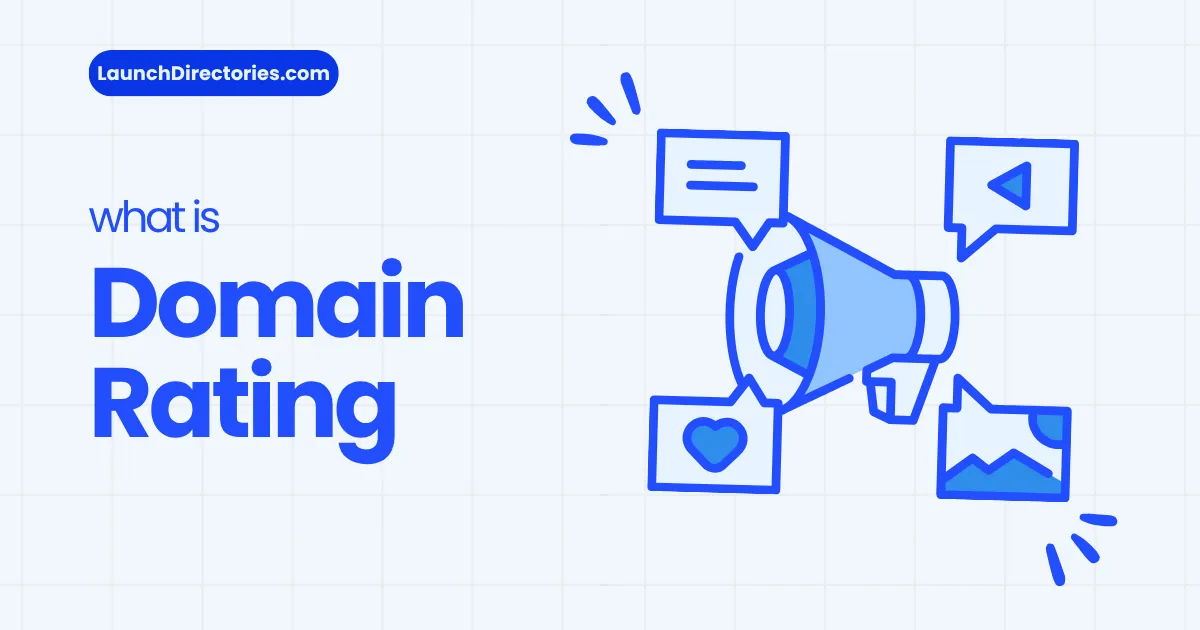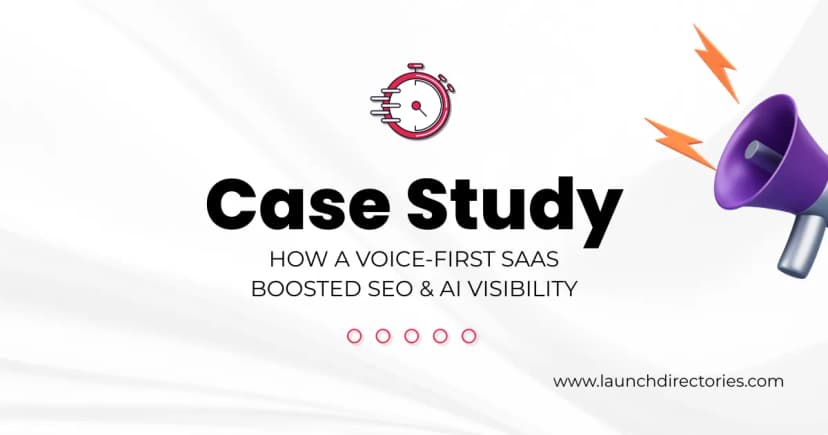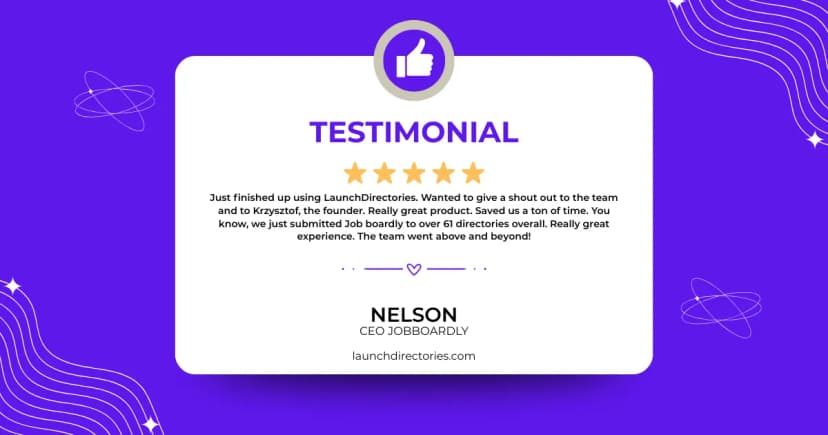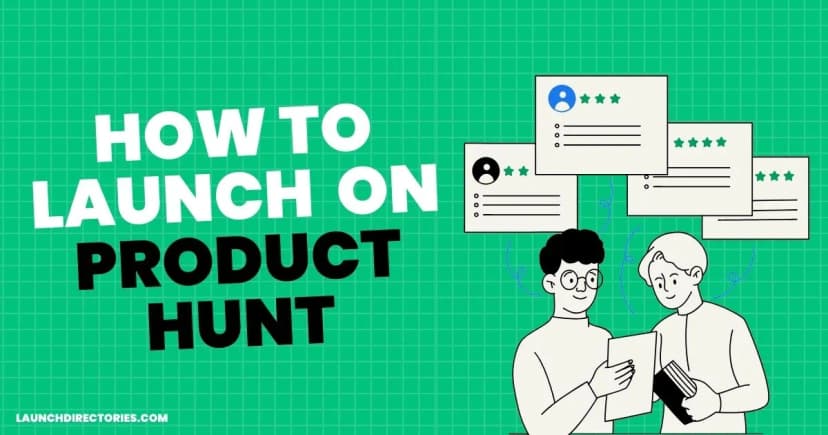If you're launching a SaaS product or building a startup, understanding Domain Rating (DR) is crucial for your SEO strategy. This comprehensive guide explains what Domain Rating is, how it's calculated, why it matters for your website's search engine performance, and proven strategies to improve it.
What is Domain Rating?
Domain Rating (DR) is a metric developed by Ahrefs that measures the overall strength of a website's backlink profile on a scale from 0 to 100. The higher your DR score, the more authoritative your website appears based on the quality and quantity of external websites linking to you.
Domain Rating was originally developed by the SEO toolset Ahrefs to estimate the strength of a website's backlink profile. It provides a quick snapshot of your site's link authority—essentially how trusted and established your domain appears to search engines.
For SaaS companies and startups, DR is particularly important because you're often competing against established players with years of backlink history. Understanding and actively working to improve your DR can level the playing field and help you gain visibility faster.
It's important to understand that Domain Rating is not a Google ranking factor—it's an Ahrefs metric that indicates the health of a website's backlink profile. However, the factors that contribute to a high DR (quality backlinks, authoritative links, strong link profiles) are the same factors that Google considers when ranking websites.
How Ahrefs Calculates Domain Rating
Ahrefs calculates DR by analyzing how many websites link to your domain and how authoritative those sites are. The calculation focuses specifically on two main factors:
Number of Unique Referring Domains: This measures how many different websites have at least one link pointing to your site. Ten links from ten different domains are more valuable than ten links from one domain. For SaaS companies, this means getting featured on Product Hunt, listed in SaaS directories, and mentioned in tech blogs—each unique domain adds to your DR.
Domain Rating of Linking Sites: Not all links are created equal—a single backlink from a DR90 website like TechCrunch or Product Hunt can have more impact than 100 links from DR20 blogs. The authority of sites linking to you directly influences your own DR score.
The Logarithmic Scale
DR is logarithmic, which means going from DR10 to DR20 is way easier than jumping from DR70 to DR80. This exponential difficulty means:
- DR 0-20: Relatively easy to achieve with basic link building efforts (launching on directories, initial press)
- DR 20-40: Requires consistent, quality backlink acquisition (guest posts, partnerships, mentions)
- DR 40-60: Demands strategic link building from authoritative sources (major publications, industry leaders)
- DR 60-100: Extremely difficult, requiring high-authority backlinks from major sites (think Product Hunt DR 91+, TechCrunch DR 93+)
Ahrefs assigns scores on a logarithmic scale from 0 to 100, meaning it's much harder to go from 80 to 90 than from 10 to 20. For new SaaS products, expect to spend 6-12 months reaching DR 30-40 with consistent effort.
How to Check Your Domain Rating
To check your Domain Rating, you'll need to use Ahrefs' tools:
- Go to Ahrefs Site Explorer
- Enter your domain URL (e.g., yoursaas.com)
- View your DR score in the dashboard overview
Ahrefs offers a free DR checker that shows your current score, total backlinks, and how many unique domains are linking to you. While Ahrefs offers limited free checks, a paid subscription provides comprehensive historical data, detailed backlink analysis, and competitor comparisons—essential for SaaS companies tracking SEO performance.
You can also check competitor websites using the same method, making it easy to benchmark your performance against other SaaS products in your industry.
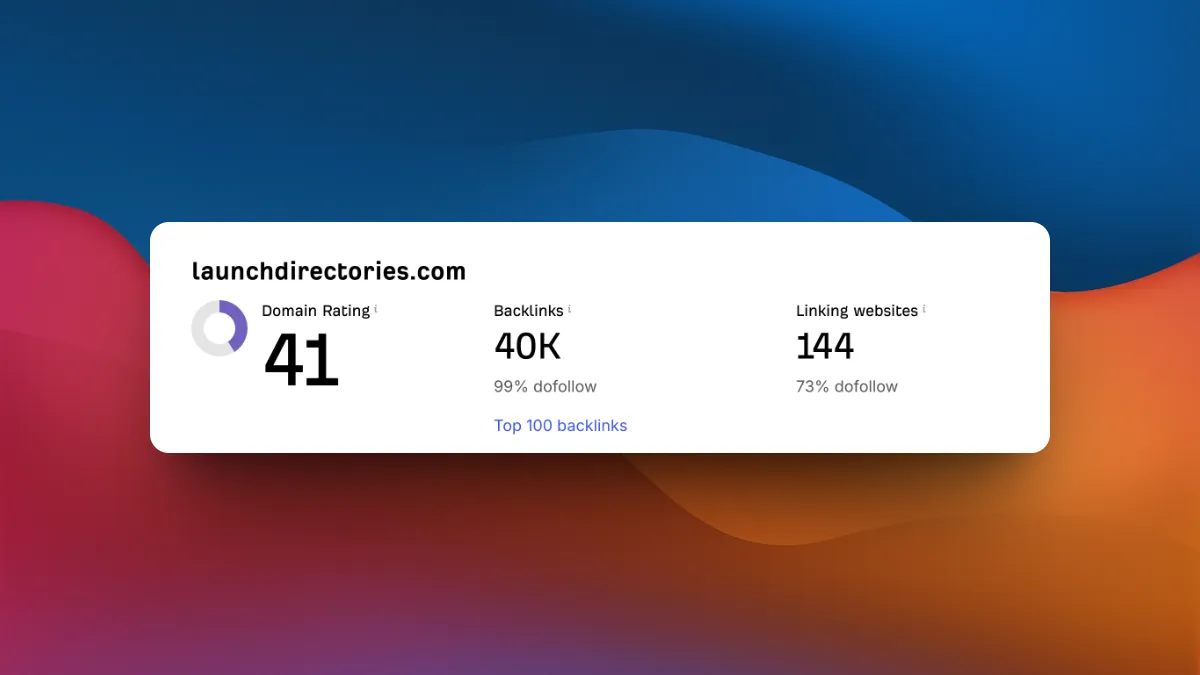
Domain Rating vs. Domain Authority: Understanding the Difference
Many people confuse Domain Rating with Domain Authority (DA), but they're different metrics from different tools:
Domain Rating (DR) - Ahrefs:
- Scores the strength of a website's backlink profile on a scale of 1 to 100
- DR only looks at link popularity and the quality of backlinks
- Focuses exclusively on external backlink factors
- Generally considered more accurate by SEO professionals due to Ahrefs' larger backlink index
Domain Authority (DA) - Moz:
- Predicts how well a website might rank on search engines
- Considers multiple ranking factors, including internal linking and domain age
- Uses machine learning to evaluate overall ranking potential
- More commonly used in marketing reports
Even though many people think these scores directly impact Google rankings, they don't. Both DR and DA are third-party metrics that serve as proxies for measuring website authority, but a high DR or DA often means a site ranks well because strong backlinks and good SEO practices influence both the scores and Google rankings—it's correlation, not causation.
For SaaS companies, most SEO tools and agencies reference DR when discussing backlink opportunities, so it's the more practical metric to focus on.
What is a Good Domain Rating for SaaS Companies?
The definition of a "good" DR score depends heavily on your industry, competition level, and website age. Here's a framework specifically for SaaS and tech startups:
DR 0-20: Newly launched SaaS products. You're just getting started with initial directory submissions and basic link building.
DR 20-35: Growing SaaS with 6-12 months of consistent SEO effort. You've secured listings on major directories and started gaining organic mentions.
DR 35-50: Established SaaS with solid authority. You're competing effectively in most niches and have earned backlinks from reputable tech publications and partner sites.
DR 50-70: Strong, authoritative SaaS domains. You have significant SEO leverage, regular press mentions, and can compete in highly competitive markets.
DR 70-100: Elite-level authority. Reserved for major SaaS platforms like Salesforce, HubSpot, or Slack—companies with years of brand recognition and thousands of high-quality backlinks.
Context Matters More Than Numbers
A SaaS tool with DR 35 can easily outrank a DR 60 competitor for specific long-tail keywords if the content is more relevant and optimized for user intent. Domain Rating gives you competitive context, but it doesn't guarantee rankings.
Consider this: many successful micro-SaaS products maintain DR 25-40 and still generate substantial revenue because they dominate specific niches. Focus on continuous improvement relative to your direct competitors rather than fixating on achieving an arbitrary number.
Why Domain Rating Matters for SaaS SEO
While DR itself isn't a Google ranking factor, it matters critically for SaaS companies for several reasons:
Competitive Benchmarking: DR provides a quick way to assess where you stand against competitors. If competing SaaS products consistently have DR 45-60 while you're at DR 25, they likely have stronger backlink profiles contributing to better organic visibility.
Link Building Strategy: When evaluating potential link opportunities (guest posting on SaaS blogs, partnerships with complementary tools, directory submissions), checking a site's DR helps determine if the backlink would be valuable. Generally, aim for links from sites with DR equal to or higher than yours.
Tracking Progress: DR serves as a measurable indicator of your link-building campaign effectiveness. For SaaS marketing teams reporting to stakeholders, DR provides a concrete metric showing SEO investment results.
Backlink Quality Indicator: The strength of your website's backlinks is measured with domain rating, helping you understand if your backlink profile consists of high-quality industry publications or low-quality spam links.
Investor and Partnership Appeal: A higher DR signals credibility. When seeking partnerships or funding, a DR 40+ domain demonstrates you've built real market presence and authority.
How to Increase Your Domain Rating: SaaS-Focused Strategies
Improving your DR requires strategic, long-term link building efforts tailored to the SaaS industry. Building domain rating is a long game, and it requires a tactical approach to SEO, marketing, and link building.
1. Launch on High-DR Startup Directories and Platforms
One of the fastest ways for new SaaS products to build initial DR is through strategic directory submissions. Getting listed on authoritative platforms provides immediate high-quality backlinks:
For maximum impact, focus on platforms with DR 70+ where your target audience actively discovers new products. High-authority launch platforms like Product Hunt (DR 91+), Hacker News (DR 92+), and Reddit communities (DR 96+) provide exceptional backlink value, while established review sites like G2 (DR 88+) and Capterra offer sustained visibility. Many of the strongest directories for SaaS companies fall in the DR 70-79 range, providing an excellent balance of authority and approval rates.
The challenge? Manually submitting to 50-100+ directories is time-consuming and easy to mess up. This is where our submission services come in!LaunchDirectories can submit your website to over 100 directories, done for you, saving hours of manual work while ensuring quality submissions that actually get approved.
with 100+ Directory Listings
Skip the grind. We'll submit your product to top directories so you get real users, feedback, and lifetime backlinks without lifting a finger.
2. Create High-Quality, Linkable SaaS Content
Creating valuable content is one of the most effective ways to boost your Domain Rating—by consistently publishing high-quality, informative, and engaging articles, you increase the chances of earning organic backlinks.
Content types that attract backlinks for SaaS:
- Industry research and data studies - Original surveys or data analysis
- Comprehensive guides - "The Complete Guide to [Your SaaS Category]"
- Comparison articles - "X vs Y" or "Best [Category] Tools"
- Integration tutorials - How to connect your tool with popular platforms
- Use case studies - Real customer success stories with data
- Alternative pages - "Best [Competitor] Alternatives"
- Free tools and calculators - ROI calculators, generators, converters
When your content is valuable and aligns with Google's E-E-A-T (Experience, Expertise, Authoritativeness, Trustworthiness) guidelines, other websites will naturally link back to you—particularly SaaS blogs, tech publications, and industry resources.
3. Implement Strategic Link Building for SaaS
Improving your domain rating revolves around acquiring more high-quality backlinks from other authoritative sites. Effective strategies for SaaS include:
Guest Blogging on SaaS Publications: Write expert articles for established SaaS blogs, tech magazines, and industry publications to earn authoritative backlinks.
Digital PR and Newsjacking: Use digital PR strategies to gain backlinks from news sites when you launch features, raise funding, or achieve milestones.
HARO (Help A Reporter Out): Respond to journalist queries related to your expertise to get quoted in major publications.
SaaS Partnership Link Exchanges: Partner with complementary SaaS tools for authentic link exchanges (integration partners, affiliate programs).
Broken Link Building: Find broken links on SaaS resource pages and offer your content as replacement.
Competitor Analysis: Use Ahrefs to analyze your competitors' backlinks and target the same high-DR sources.
4. Focus on Link Quality Over Quantity
There's no fixed number of backlinks required to increase Domain Rating—the impact depends on link quality, relevance, and diversity rather than just quantity. A few high-authority backlinks can boost DR more than hundreds of low-quality links.
For SaaS specifically:
- 1 backlink from TechCrunch > 100 backlinks from random blogs
- 1 feature on Product Hunt > 50 directory listings from DR 20 sites
- 1 partnership with complementary SaaS (DR 60) > dozens of forum links
Prioritize acquiring do-follow links from reputable high-domain authority websites in the tech and SaaS space, ensuring high-quality content and backlinks.
5. Diversify Your Referring Domains
Effective link prospecting to maximize the number of unique domains linking back to your site is crucial for enhancing its overall authority and visibility. Rather than getting multiple links from the same sources, focus on expanding the variety of domains linking to you.
SaaS-specific referring domain sources:
- Tech publications (TechCrunch, VentureBeat, The Verge)
- SaaS review platforms (G2, Capterra, Software Advice)
- Industry blogs and newsletters
- Podcast show notes (if you're featured as a guest)
- YouTube video descriptions (product reviews, tutorials)
- Integration partner websites
- Customer case studies on their domains
- University or research institution mentions
Each new referring domain (especially high-quality ones) has more impact than additional links from domains already linking to you.
6. Leverage Product Integrations for Backlinks
One underutilized strategy for SaaS companies is building integrations with popular platforms. When you create official integrations with tools like Zapier, Slack, Salesforce, or HubSpot, you often earn backlinks from:
- Their integration marketplace pages
- Their official documentation
- Partner directories
- Press releases announcing the integration
A single integration with a major platform can provide multiple high-DR backlinks and drive significant referral traffic.
7. Optimize Technical SEO
Understanding SEO fundamentals can significantly influence a site's Domain Rating score, as enhanced user experience fosters popularity and naturally attracts more inbound domain links.
Key technical optimizations for SaaS sites:
- Ensure mobile responsiveness (critical for product pages)
- Improve page load speed (use CDNs, optimize images, minimize JavaScript)
- Implement proper site structure and internal linking
- Use HTTPS encryption (essential for trust)
- Create and submit XML sitemaps
- Fix crawl errors and broken pages
- Implement schema markup for SaaS products
- Optimize for Core Web Vitals
These technical foundations make your site more crawlable and user-friendly, amplifying the impact of your backlinks.
Common Domain Rating Mistakes SaaS Companies Make
Buying Random Links: Purchased or spammy links can harm your site's reputation with Google. Many SaaS founders are tempted by "quick DR boost" services - avoid them.
Focusing Only on DR: Don't obsess over the number. A site with lower DR but better product-market fit and conversion optimization will always outperform a high-DR site with poor user experience.
Ignoring Link Relevance: Getting a backlink from a high-DR fashion blog doesn't help your B2B SaaS tool. Focus on tech, business, and industry-relevant links.
Skipping Directory Submissions: Many SaaS founders underestimate directory submissions, thinking they're "old school." Strategic directory placements on high-DR platforms remain one of the fastest ways to build initial authority.
Expecting Quick Results: Building domain rating takes 6-12 months of consistent effort. Dramatic DR increases in short periods often indicate unnatural link building practices that could trigger penalties.
Neglecting Content Quality: No amount of backlinks can compensate for poor content. Your blog, documentation, and landing pages must provide real value.
One-Time Launch Efforts: Launching on Product Hunt once isn't enough. Consistent content marketing, PR, and link building are required for sustained DR growth.
Tracking Domain Rating Over Time
Monitor your DR regularly (monthly or quarterly) to assess your SEO progress:
- Use Ahrefs Site Explorer to track DR history and identify trends
- Compare against competitors to maintain relative positioning in your SaaS category
- Analyze which link building efforts correlated with DR increases (did that TechCrunch mention spike your DR?)
- Monitor referring domains growth alongside DR changes
- Check for sudden drops that might indicate lost backlinks (a directory shut down, a partner removed your link)
- Track DR alongside organic traffic to see if higher authority translates to more visitors
Remember that your domain rating will increase or decrease because of factors both inside and outside of your control. A major publication might link to you organically, or a high-DR backlink might disappear if a site goes offline. Focus on the controllable factors like content quality, strategic outreach, and technical optimization.
Tools for Checking Domain Rating
While Ahrefs is the creator of Domain Rating, several tools provide similar authority metrics:
- Ahrefs: Original DR metric, most comprehensive backlink database, preferred by most SaaS SEO professionals
- Moz: Domain Authority (DA) metric with similar purpose
- SEMrush: Authority Score metric
- Ubersuggest: Domain Score (simplified version)
For SaaS companies, Ahrefs is the industry standard. If budget is limited, start with their $129/month plan, which provides full DR tracking and competitor analysis.
Getting Started: Your 90-Day DR Improvement Plan
Days 1-30: Foundation
- Check your current DR in Ahrefs
- Audit existing backlinks and identify top referring domains
- Submit to 10-15 high-DR launch platforms (Product Hunt, Hacker News, etc.)
- Publish 2-3 comprehensive blog posts targeting linkable topics
- Set up Google Alerts for your brand to monitor new mentions
Days 31-60: Expansion
- Launch guest posting outreach to 20 SaaS blogs
- Submit to 50-100 additional directories (or use a submission service to handle this)
- Create one data-driven industry report or original research
- Reach out to 10 complementary SaaS tools for partnership/link opportunities
- Optimize 5 existing blog posts for better linkability
Days 61-90: Acceleration
- Respond to 5-10 HARO queries in your industry
- Launch a free tool or resource that attracts backlinks
- Secure 2-3 podcast appearances or interviews
- Write 3 guest posts for high-DR publications
- Analyze competitors who gained DR and replicate their strategies
Pro Tip: If manually managing 100+ directory submissions sounds overwhelming, consider using a service that handles bulk submissions professionally. LaunchDirectories can submit your website to over 100 directories, done for you—saving you 20-30 hours of manual work while ensuring submissions are completed correctly with proper descriptions, categories, and follow-ups.
with 100+ Directory Listings
Skip the grind. We'll submit your product to top directories so you get real users, feedback, and lifetime backlinks without lifting a finger.
Conclusion
Domain Rating provides crucial insights into your SaaS website's backlink strength and competitive positioning. While it's not a direct ranking factor, understanding and actively improving DR helps you build the foundation for long-term organic growth.
Key takeaways for SaaS founders:
- DR is an Ahrefs metric measuring backlink profile strength on a 0-100 scale
- It's logarithmic, making each point harder to gain as you climb higher
- Quality beats quantity—one TechCrunch backlink > 100 random blog links
- It's a proxy metric that correlates with SEO success and business growth
- Improvement takes time—expect 6-12 months to see significant changes
- Strategic directory submissions are one of the fastest ways to build initial DR
- Content + outreach are the long-term engines of DR growth
Focus on earning high-quality backlinks through ethical practices, create valuable content that naturally attracts links, launch strategically on high-DR platforms, and optimize your technical SEO. With consistent effort and the right strategies, you'll see your DR—and more importantly, your organic traffic, trial signups, and revenue—grow steadily over time.
Start tracking your DR today, benchmark against competitors, and implement the strategies that align with your resources. Whether you're at DR 10 or DR 50, there's always room for improvement, and every point gained represents real SEO progress for your SaaS business.
